Tag Archive: SGD
February 25, 2013
by Carole Zangari -
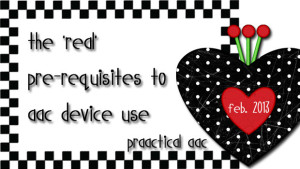
How long did you practice your driving skills before you took your driver’s license road test? A week? A month? A couple of months? We love videos like this one that show kids in the process of developing skills with technology. It’s not usually a quick and easy process, but if we prepare ourselves and the families with whom we work for the process, good things will happen. Little Eva and her family remind us that kids don’t have to ‘prove’ readiness for high tech AAC. They deserve opportunities to use these tools to learn, develop, and grow. The next time that people tell you that one of your clients with complex communication needs ‘isn’t ready’ for AAC technology, you might want to ask them how things might have gone if they had taken the road test a few days after their first time behind the wheel. We needed practice.... [Read More...]
Filed under: PrAACtical Thinking
Tagged With: eye gaze, pre-requisites, Rett, SGD
February 20, 2013
by Carole Zangari -
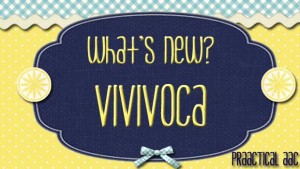
It’s always exciting when we see new ideas take shape in AAC tools. Take a look at the research on VIVIVOCA: voice-input, voice-output communication aid. This holds much promise for clients who have poor speech intelligibility but good consistency in their error patterns, such as people with dysarthria secondary to cerebral palsy. Here’s the article. Thanks to the indefatigable Ian Bean for alerting us to this article. Hawley, M.S., Cunningham, S.P., Green, P.D., Enderby, P., Palmer, R., Sehgal, S., & O’Neill, P. (2013). A voice-input voice-output communication aid for people with severe speech impairment. IEEE Transactions on Neural Systems and Rehabilitation Engineering, 21, 1, 23-31.
Filed under: PrAACtical Thinking
Tagged With: article, journal article, research, SGD, speech recognition
December 4, 2012
by Carole Zangari -

Earlier this fall, I spoke with an SLP who was beginning to serve a new classroom of students with significant disabilities, including many kids with AAC needs. Jenna had been into the classroom a few times to meet the teacher and the kids, and get a sense of the daily schedule, curriculum, and materials. She was (rightfully) concerned about how few AAC materials were available and we strategized a little bit about a long-range plan to address that. In the short term, though, we decided to focus on what they DID have in that classroom. Among the treasures, a sequential message communication device. What Are Sequential Message Communication Devices? These are simple devices that let you record messages in segments and then replay them in that same order. The initial activation of the device speaks the first part of the message aloud and then stops. When you activate the device... [Read More...]
Filed under: PrAACtical Thinking
Tagged With: implementation ideas, sequential message device, SGD
November 27, 2012
by Carole Zangari -

Between the craziness of the election, the stress of Superstorm Sandy, some frustration over some blog issues, and the pace of getting ready for the ASHA convention, we were ready for a little levity. It seemed like just the time to rustle up some jokes that could be programmed on an SGD, an AAC app, or a sequential message device. If you need a laugh, too, here’s a list of places to check out for some jokes that may work for the AAC learners you know. Jokes for Every Season – From Ducksters Knock Knock Jokes – From Funology More Knock Knock Jokes – A whole website full of them Jokes by Category – From Activity Village Why Did the Chicken Cross the Road? Jingle Jokes from Kelly Martin Christmas Jokes from the Nurture Store Photo courtesy of Silver Lining Multimedia via Picture This Pro
Filed under: PrAACtical Thinking
Tagged With: humor, jokes, sequential message device, SGD
November 14, 2012
by Carole Zangari -

Want to help AAC learners accelerate their receptive vocabularies? Here’s one quick and easy step in the right direction: Talk to them. We’re not trying to be snarky here. The truth is that we speak less to people who are minimally verbal than we do to people who talk. In general, kids with AAC needs hear far less language than speaking children do. Fewer words heard means fewer opportunities to learn language. That’s a cycle worth breaking. When we’re around typically developing children, they’re always asking questions. “What’s in the bag, Mom?” “Why is she doing that?” “How come Billy gets to have one and I don’t?” “Where are we going?” “Are we there yet?” Kids ask lots of questions, particularly in the early years. Annoying? Sometimes. Valuable? Always. From a language learning perspective, those pesky questions serve a very useful purpose: they invite (or demand) a linguistic response. They... [Read More...]
Filed under: PrAACtical Thinking
Tagged With: intervention, language magnets, messages, questions, SGD, vocabulary, word learning
August 26, 2012
by Carole Zangari -
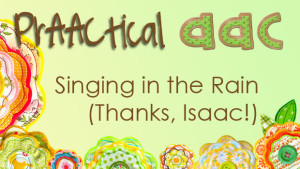
By tradition, we post an AAC-related video on Sundays. Today, we’re thinking that it’s time for a song, and those who attended ISAAC 2012 know that there’s nothing like the songs sung using AAC. This video features an adaptation of a classic folk song, If I Had a Hammer, performed by the talented Snoopi Botten. Direct Link to Video: https://www.youtube.com/watch?v=XG0kXjXu2Yo
Filed under: Video of the Week
Tagged With: SGD, singing, song
July 28, 2012
by Carole Zangari -
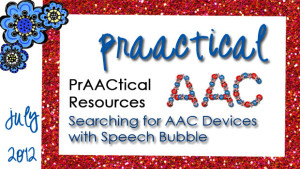
Keeping track of all the AAC devices, vocabulary sets, and other features is a full time job and few of us have the time to do that. And, yet, when we’re considering the different AAC options for a particular client, we have to be able to access that information. Looking for SGDs that have a specific vocabulary set? Need to identify the small, handheld AAC devices? Looking for devices that do voice calling? – Finding an AAC device that is a good fit for the people with whom you work is much easier when you have a searchable database. In the US, many professionals are familiar with AbleData and use it to find equipment that fit the bill. SpeechBubble is another free resource that indexes AAC devices in the UK. – Search by Feature SpeechBubble makes it easy to search for features you know that your client needs. There is... [Read More...]
Filed under: PrAACtical Thinking
Tagged With: assessment, resources, SGD
July 22, 2012
by Carole Zangari -
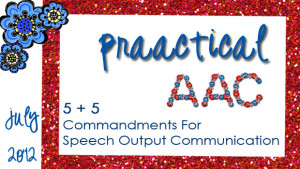
Once in awhile, we come across something that is just too good to keep to ourselves and has to be shared in its entirety. This post is a paraphrase of the Ten Commandments for Voice Output by the Provincial Integration Support Program (PISP) from the Ministry of Education in British Columbia. – You can get the original document here. – Ten Commandments for Voice Output 1. The AAC device is the student’s voice. Messages should be in the first person and reflect the age and gender of the user. 2. The learner needs full access to the device as well as many planned opportunities each day to use it. 3. With training, peers can and should be involved in the programming process. 4. People need to communicate all day long. The device should be available to the communicator at all times. 5. Messages should be meaningful to the... [Read More...]
Filed under: PrAACtical Thinking
Tagged With: implementation ideas, inclusion, SGD, speech output
February 29, 2012
by Carole Zangari -
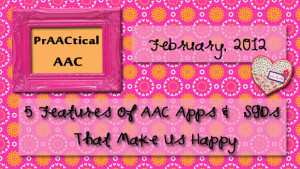
1. Doing a back-up or restore by email? Sounds good to us! Thanks, PictureCanTalk. 2. Allowing people to explore all of the available vocabulary without interfering with the page programming is the AAC equivalent of babbling in the app Speak for Yourself. 3. Ability to turn off the history feature and clear prior communications when privacy is a concern. Noted and appreciated in SonoFlex, Predictable, and other AAC apps/SGDs. 4. Auditory scanning has long been of value in SGDs and now it’s gone mobile. Kids with visual impairment or poor head control appreciate this feature in apps like Sounding Board. 5. Voice morphing: Electronically altering recorded speech. Can’t someone please bring back the awesome vocal aesthetics that were in the Tango? We’re still grieving that loss.
Filed under: PrAACtical Thinking
Tagged With: Apps, SGD
February 12, 2012
by Carole Zangari -

Some people thrive on conflict. Not us. We’re happiest when things are running smoothly and everyone is getting along. Nonetheless, we’re secretly thrilled by the conflict that has erupted between apps and traditional SGDs. — Here’s what we love about this conflict. 1. We LOVE that the technology that launched this controversy has raised the public’s awareness of AAC as an option. AAC in the local papers and New York Times. AAC on 60 minutes and segments of the nightly news. No matter how you feel about apps versus traditional SGDs, you gotta love the fact that more people now know that there are tools out there for people with little or no functional speech. – 2. We LOVE that AAC technology has progressed to a point where there is something to argue about. When I started my AAC career, the Express 3 (PRC), Zygo 100 (Zygo), and the HandiVoice... [Read More...]
Filed under: PrAACtical Thinking
Tagged With: Apps, historical perspective, SGD, technology









